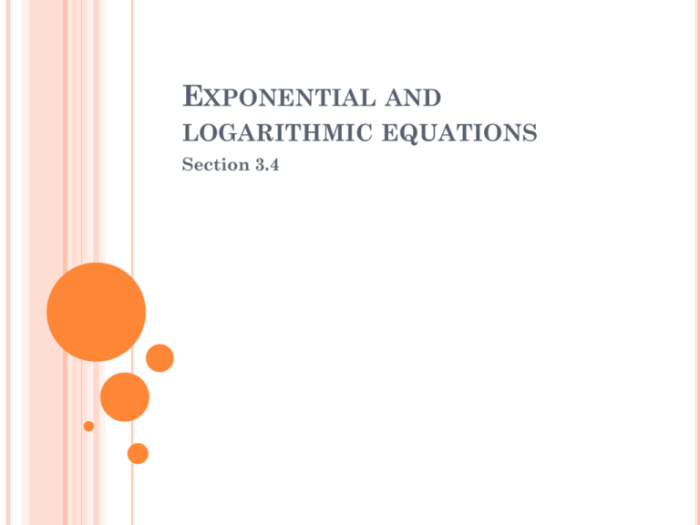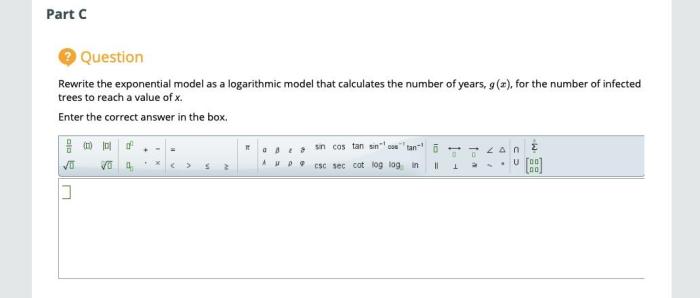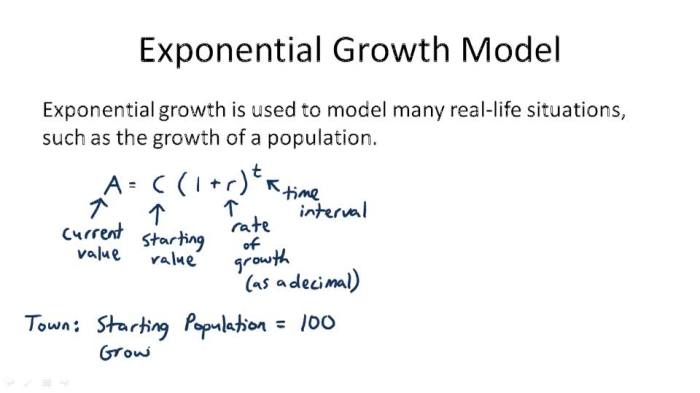The modeling with exponential and logarithmic equations assignment delves into the fascinating world of mathematical modeling, where we explore the power of these equations to represent real-world phenomena. This guide provides a comprehensive overview of the concepts, properties, and applications of exponential and logarithmic functions, empowering you to tackle complex modeling challenges with confidence.
Exponential equations model exponential growth and decay, while logarithmic equations model the inverse relationship between exponential functions and their arguments. Understanding these equations is crucial for applications in various fields, including science, engineering, finance, and population modeling.
Modeling with Exponential Equations: Modeling With Exponential And Logarithmic Equations Assignment
Exponential equations model exponential growth and decay. They have the form y = ab^x, where a is the initial value, b is the growth or decay factor, and x is the independent variable.
Examples:
- y = 2^x models exponential growth with an initial value of 2 and a growth factor of 2.
- y = 100e^(-0.05x) models exponential decay with an initial value of 100 and a decay factor of 0.05.
Properties:
- Exponential equations are always increasing or decreasing.
- The growth or decay factor is always positive.
- The initial value is the y-intercept.
Modeling with Logarithmic Equations

Logarithmic equations model the inverse of exponential equations. They have the form log b(y) = x, where b is the base, y is the argument, and x is the logarithm of y to the base b.
Examples:
- log 2(8) = 3 because 2^3 = 8.
- ln(e^2) = 2 because e^2 = e^2.
Properties:
- Logarithmic equations are always increasing or decreasing.
- The base is always positive and not equal to 1.
- The argument is always positive.
Solving Exponential and Logarithmic Equations

Exponential equations:
- Isolating the exponent:Rewrite the equation in the form b^x = c, then take the logarithm of both sides to get x = log b(c).
- Using logarithms:Rewrite the equation in the form y = ab^x, then take the logarithm of both sides to get log(y) = log(ab^x) = x log(b).
Logarithmic equations:
- Isolating the argument:Rewrite the equation in the form log b(y) = x, then exponentiate both sides with base b to get y = b^x.
- Using exponential equations:Rewrite the equation in the form y = log b(x), then solve the exponential equation b^y = x.
Applications of Exponential and Logarithmic Functions

Exponential functions:
- Population growth and decay
- Radioactive decay
- Compound interest
Logarithmic functions:
- Measuring earthquakes (Richter scale)
- Sound intensity (decibels)
- pH levels
Detailed FAQs
What are the key differences between exponential and logarithmic equations?
Exponential equations involve raising a constant base to a variable exponent, while logarithmic equations express the exponent as a function of the base. Exponential equations model growth and decay, while logarithmic equations model inverse relationships.
How do I solve exponential equations?
To solve exponential equations, we isolate the exponential term on one side and take the logarithm of both sides. This converts the equation into a logarithmic equation, which can be solved using the properties of logarithms.
What are some real-world applications of exponential and logarithmic functions?
Exponential functions model exponential growth and decay in phenomena such as population growth, radioactive decay, and compound interest. Logarithmic functions are used in pH calculations, decibel measurements, and the Richter scale for earthquake magnitudes.